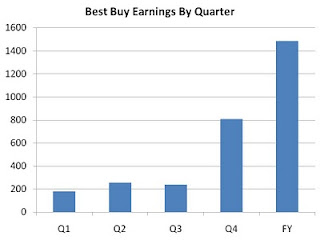As a retailer of consumer electronics, Best Buy receives a disproportionate amount of income in the quarter which covers the December period. Consider the following graph, which depicts Best Buy’s earnings by quarter and for the full year:
Clearly, the first three quarters play only a small role in determining the success of Best Buy’s year. Despite this, the company’s stock price fluctuates dramatically based on how well results in these quarters match-up with expectations.
For example, between the months of April and September of this year, the stock price traded between a range of $30 and $49 per share. Did the company’s value really change by more than 60%, or is the market merely overreacting to some rather inconsequential quarterly reports?
I would argue the latter. Best Buy is an incredibly stable business, as shown by its return on invested capital levels over the last several years. Furthermore, Best Buy’s streak of generating excellent returns continues, as its return on equity (ROE) over the last 12 months is 24%.
But because the market overreacts to quarterly misses, investors are offered great entry points for this stock. Two weeks ago, Best Buy reported operating income that was higher than it was last year, but that missed expectations. As a result, the stock fell dramatically; the company now trades at a P/E of just 8, based on its current market cap and its last 12 months of earnings.
Market overreactions with this stock are rather common. Long-term investors can take advantage of the situation by buying when the stock gets punished to low P/E levels, and selling when positive sentiment returns.
Disclosure: Author has a long position in shares of BBY




